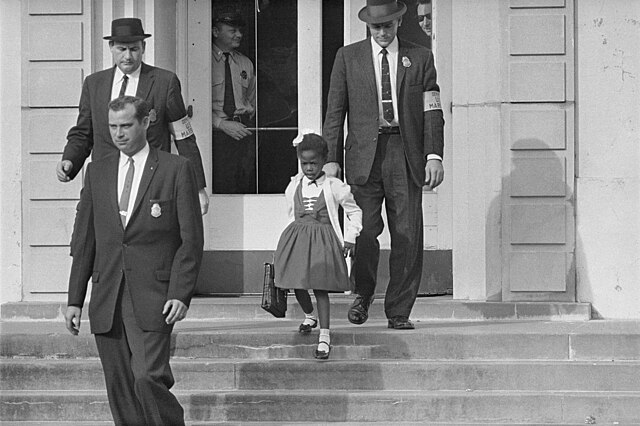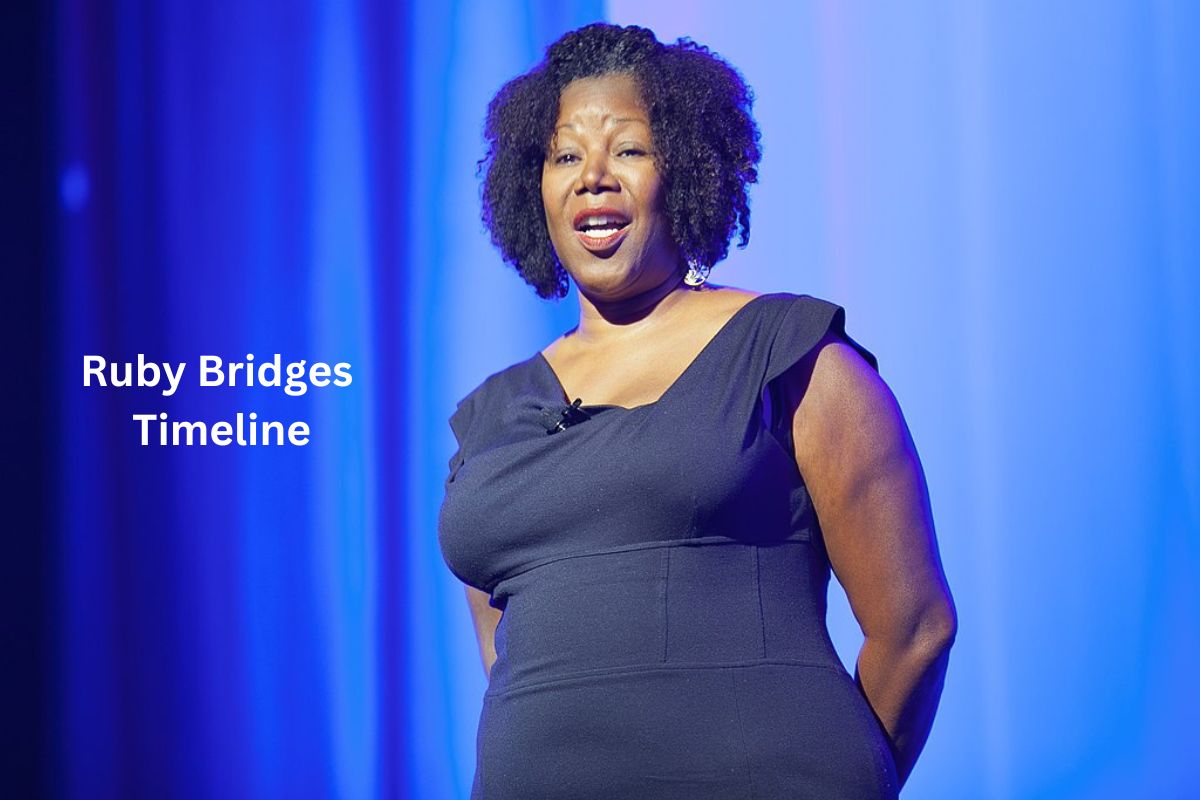Ruby Bridges is a prominent American civil rights activist known for her groundbreaking role in the desegregation of public schools in the United States. Born on September 8, 1954, in Tylertown, Mississippi, Bridges moved to New Orleans with her family in 1958.
In a landmark event in 1960, at the tender age of six, she became one of the first African-American children to attend an all-white elementary school in the South, the William Frantz Elementary School.
The act, which occurred six years after the U.S. Supreme Court’s decision in Brown v. Board of Education declared segregated schools unconstitutional, provoked a strong reaction from a society deeply divided over racial issues.
Despite facing daily threats and hostility, Bridges continued attending classes, demonstrating remarkable courage and resilience.
Ruby’s story has inspired numerous works of art and literature, and she has received significant recognition for her role in advancing civil rights. She has dedicated her life to promoting tolerance and equality, including establishing the Ruby Bridges Foundation in 1993.
| Year | Event |
|---|---|
| 1954 | Ruby Nell Bridges was born in Tylertown, Mississippi. |
| 1958 | The Bridges family moved to New Orleans, Louisiana. |
| 1960 | Ruby became one of the first African-American children to desegregate the all-white William Frantz Elementary School in New Orleans, Louisiana. |
| 1960-1961 | Ruby was taught by Barbara Henry in a class of one. Parents of white children pulled their kids out of school due to the desegregation. |
| 1964 | Artist Norman Rockwell portrayed Bridges in the painting “The Problem We All Live With.” |
| 1993 | Ruby Bridges Hall established The Ruby Bridges Foundation. |
| 1995 | The Children’s Museum of Indianapolis opened an exhibit recreating her first grade classroom. |
| 1999 | Ruby Bridges wrote an award-winning autobiography, “Through My Eyes.” |
| 2001 | President Bill Clinton awarded Ruby Bridges with the Presidential Citizens Medal. |
| 2014 | A statue of Ruby was unveiled outside the William Frantz Elementary school. |
Timeline of Ruby Bridges
1954 – Ruby Nell Bridges was born in Tylertown, Mississippi
Ruby Nell Bridges was born in Tylertown, Mississippi on September 8, 1954. She was born during a time when racial segregation was widespread across the United States, especially in the Southern states.
Also Read: Ruby Bridges Accomplishments
The youngest of five children, she was born to Abon and Lucille Bridges, who were sharecroppers, meaning they farmed someone else’s land in return for a share of the crops.
1958 – The Bridges family moved to New Orleans, Louisiana
When Ruby was around four years old, her parents, Abon and Lucille Bridges, decided to move the family to New Orleans, Louisiana, in search of better opportunities.
Also Read: Ruby Bridges Facts
The South was still heavily segregated at this time, but New Orleans offered more employment opportunities compared to rural Mississippi. Ruby’s father got a job as a service station attendant and her mother took night jobs to help support their growing family.

1960 – Ruby became one of the first African-American children to desegregate the all-white William Frantz Elementary School in New Orleans, Louisiana
Ruby became one of the first African-American children to desegregate the all-white William Frantz Elementary School in New Orleans, Louisiana, on November 14, 1960.
She was one of six African-American students in New Orleans to pass the test that determined whether or not the black students could attend the white school.
However, out of the six, only Ruby and one other student decided to attend. Ruby had to be escorted by four federal marshals on her first day at school and throughout her first year there because of violent mobs protesting the desegregation.
The decision to send her to the previously all-white school was a landmark moment in the fight against segregation in the United States, making Ruby a symbol of the Civil Rights Movement at the tender age of six.
1960-1961 – Ruby was taught by Barbara Henry in a class of one
Throughout the academic school year, Ruby was taught by a young Boston native, Barbara Henry, in a class of one. Because parents of white students pulled their children out of school in protest of the desegregation, Ruby was the only student in her class.
Ms. Henry, who believed that all children deserved an equal opportunity to learn, bravely crossed the picket lines to teach Ruby, setting up a one-student classroom. Despite the hostile environment, Ruby never missed a day of school that year.
1964 – Artist Norman Rockwell portrayed Bridges in the painting “The Problem We All Live With”
Renowned artist Norman Rockwell portrayed Ruby Bridges in a painting titled “The Problem We All Live With”. It was first published in Look magazine on January 14, 1964.
The painting depicted Ruby, flanked by federal marshals, walking to school past a wall scrawled with a racial slur and smeared with tomatoes.
The illustration, featuring a little black girl in a white dress carrying her school supplies and a ruler, became one of the most iconic images of the Civil Rights Movement.
1993 – Ruby Bridges Hall established The Ruby Bridges Foundation
Ruby Bridges Hall established The Ruby Bridges Foundation in New Orleans. The foundation promotes the values of tolerance, respect, and appreciation of all differences.
Through educational programs, it encourages and inspires children to break down racial barriers. The foundation’s mission reflects Ruby’s belief that racism can be eliminated if children are taught to respect and accept those different from themselves.
1995 – The Children’s Museum of Indianapolis opened an exhibit recreating her first grade classroom
The Children’s Museum of Indianapolis opened an exhibit recreating her first-grade classroom. This exhibit was designed to help children understand the context and significance of Ruby Bridges’ brave act in the face of adversity.
It provided an opportunity for kids to learn about the desegregation of schools in the United States and the broader civil rights movement.
1999 – Ruby Bridges wrote an award-winning autobiography, “Through My Eyes”
Ruby Bridges published an award-winning autobiography, “Through My Eyes.” The book shares her perspective of the events that transpired during her early years.
It recounts her first year at the William Frantz Elementary School, the hostility she faced, and her strength and courage during that time. This book won the Carter G. Woodson Book Award in 2000.
2001 – President Bill Clinton awarded Ruby Bridges with the Presidential Citizens Medal
President Bill Clinton awarded Ruby Bridges with the Presidential Citizens Medal. This is the second highest civilian award in the United States, given to individuals “who [have] performed exemplary deeds or services for his or her country or fellow citizens.”
It was a recognition of Ruby’s role and contribution to the Civil Rights Movement and her continued work in promoting racial equality.
2014 – A statue of Ruby was unveiled outside the William Frantz Elementary school
A statue of Ruby Bridges was unveiled outside the William Frantz Elementary School. The statue commemorates her historic walk and the desegregation of the school. Sculpted by artist Franco Alessandrini, it stands as a permanent reminder of Ruby’s courage and the progress made in the fight against racial segregation in education.
